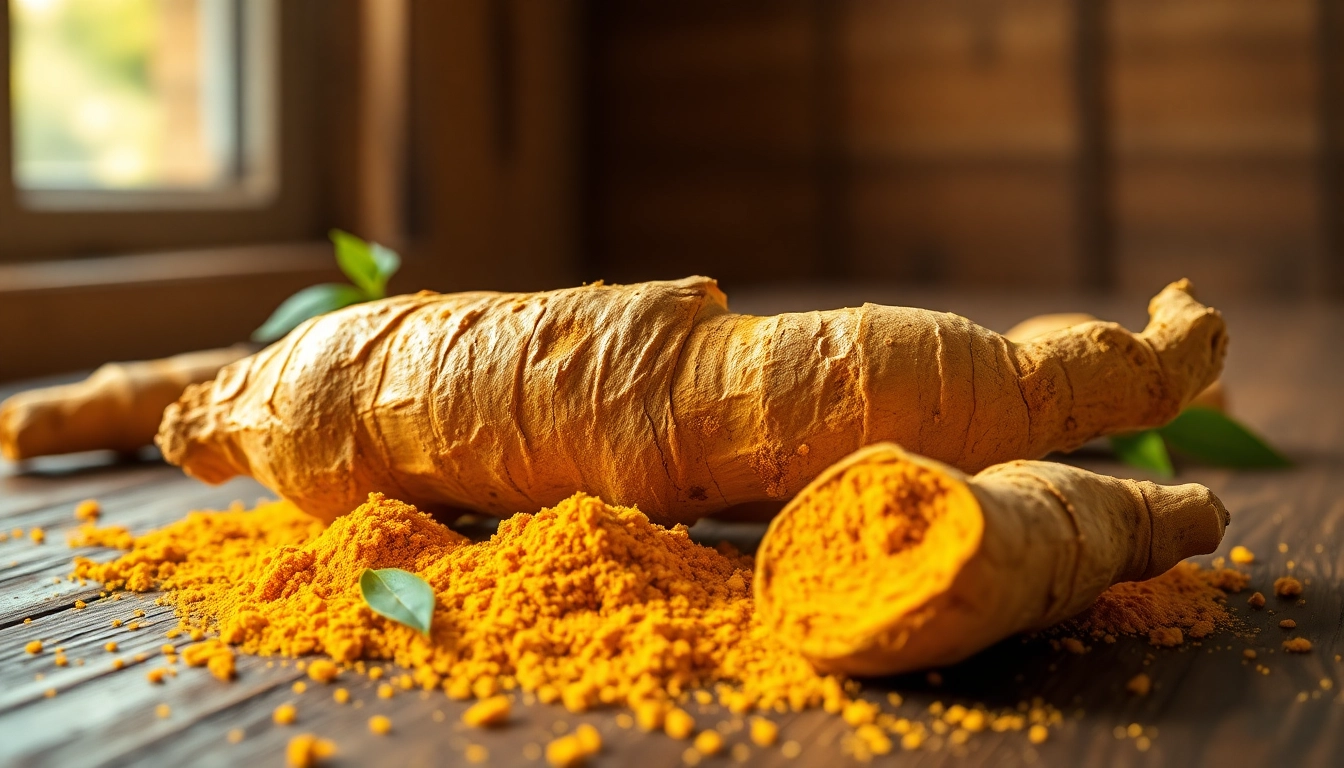
The Fundamentals of Turmeric Root
1. What is Turmeric Root?
Turmeric root, known scientifically as Curcuma longa, is the rhizome of a flowering plant belonging to the ginger family, Zingiberaceae. This vibrant, golden-yellow root has been harvested for its culinary and medicinal qualities for thousands of years, primarily in Asia. With a flavor profile that offers warmth and a slight bitterness, turmeric is commonly used in a variety of dishes, particularly in South Asian and Middle Eastern cuisines. Its most notable compound, curcumin, is responsible for many of its health benefits and gives the root its characteristic color.
2. Nutritional Profile of Turmeric Root
The nutritional value of turmeric root is impressive, making it a beneficial addition to any diet. A typical serving of fresh turmeric root (about one ounce or 28 grams) contains approximately:
- Calories: 24
- Carbohydrates: 5 grams
- Protein: 0.5 grams
- Fat: 0.1 grams
- Fiber: 1.4 grams
- Vitamin C: 0.6 mg (1% RDI)
- Iron: 0.9 mg (5% RDI)
- Manganese: 0.3 mg (15% RDI)
Additionally, turmeric is known for containing several bioactive compounds, including curcumin, which is recognized for its anti-inflammatory and antioxidant effects. These nutrients work collectively to support various aspects of health, from digestive function to immune response.
3. Historical and Cultural Uses
Turmeric has a rich history intertwined with various cultures, particularly in India and China. In Ayurveda, the traditional Indian system of medicine, turmeric is revered as a powerful healing herb. It has been used to treat a range of conditions, including respiratory issues, joint pain, and skin ailments. Its anti-inflammatory properties are celebrated, and it serves as a natural remedy for overall wellness.
In addition to health applications, turmeric has historically been used as a dye and for ceremonial purposes. In many cultures, it is considered auspicious and is often included in weddings and other significant rituals. Its vibrant hue symbolizes purity and fertility, reinforcing its importance in cultural practices.
Health Benefits of Turmeric Root
1. Anti-inflammatory Properties
Curcumin, the most active component of turmeric, has been extensively studied for its anti-inflammatory effects. Chronic inflammation is recognized as a precursor to various diseases, including heart disease, cancer, and neurodegenerative conditions. Research has shown that curcumin can inhibit the activity of inflammatory molecules, thus reducing inflammation in the body.
A 2020 study published in Johns Hopkins Medicine highlighted that curcumin’s ability to modulate inflammation pathways can benefit conditions like arthritis and may help alleviate pain and stiffness associated with it. Regular intake may support a healthier inflammatory response, making turmeric a valuable addition to anti-inflammatory diets.
2. Antioxidant Effects
Turmeric root boasts potent antioxidant properties, primarily attributed to curcumin. Antioxidants are vital for neutralizing free radicals—unstable molecules that can cause oxidative stress and lead to cellular damage. By increasing the body’s antioxidant capacity, curcumin can protect cells from damage that contributes to aging and diseases.
Studies have shown that consistent consumption of turmeric can enhance the body’s own antioxidant enzymes, providing a dual approach to combating oxidative stress. This is especially beneficial for maintaining brain health and reducing the risk of neurodegenerative diseases, as oxidative damage in the brain is a significant factor in conditions like Alzheimer’s disease.
3. Potential Role in Disease Prevention
The collective benefits of turmeric root, particularly its anti-inflammatory and antioxidant properties, suggest a potential role in disease prevention. Research indicates that curcumin may help lower the risk of chronic diseases by influencing several biological pathways. For instance, its effects on blood sugar regulation indicate potential benefits for individuals with diabetes and metabolic syndrome.
A systematic review conducted in 2021 gathered evidence on the anticancer properties of curcumin, emphasizing its ability to inhibit cancer cell growth and metastasis across various cancer types, including breast, prostate, and colorectal cancers. While more human clinical trials are needed to establish definitive conclusions, these findings highlight turmeric’s promising role as a complementary approach in integrative medicine.
Culinary Applications of Turmeric Root
1. Cooking with Fresh Turmeric Root
Incorporating fresh turmeric root into your diet can be both delicious and beneficial. The root’s strong, earthy flavor can enhance an array of dishes. Some popular methods of using fresh turmeric include:
- Steeping in teas for a soothing beverage.
- Grating into smoothies for a nutritional boost.
- Adding to stir-fries for a warm, spicy undertone.
- Infusing in soups and curries to deepen their flavor complexity.
- Using it in marinades for meats and vegetables.
When cooking with turmeric, consider pairing it with black pepper. Piperine, the active compound in black pepper, has been shown to enhance the absorption of curcumin by up to 2,000%, maximizing the health benefits.
2. Recipes Featuring Turmeric Root
Here are a few favorite recipes incorporating fresh turmeric root:
Turmeric Ginger Tea
Ingredients:
- 1 piece of fresh turmeric root, grated
- 1 piece of fresh ginger root, grated
- 2 cups of water
- 1 tablespoon honey (optional)
- Juice of half a lemon
Instructions:
- In a saucepan, boil the water.
- Add the grated turmeric and ginger, and let it steep for 10-15 minutes.
- Strain the mixture into a cup, add honey and lemon juice to taste, and enjoy.
Turmeric Curry
Ingredients:
- 1 tablespoon oil
- 1 onion, chopped
- 2 cloves garlic, minced
- 1 piece of fresh turmeric root, grated
- 1 teaspoon cumin
- 1 can coconut milk
- 2 cups mixed vegetables
- Salt and pepper to taste
Instructions:
- Heat the oil in a pan and sauté the onion and garlic until golden.
- Add the grated turmeric and cumin, cooking for another minute.
- Pour in the coconut milk and add the vegetables. Simmer until the veggies are tender.
- Season with salt and pepper and serve over rice.
3. Pairing Turmeric with Other Ingredients
Turmeric is versatile and pairs well with a variety of ingredients. Here are some ideal companions:
- Ginger: Both spices complement each other, enhancing flavor and health benefits.
- Coconut milk: Provides a creamy texture that balances turmeric’s earthiness.
- Black pepper: Significantly improves the absorption of curcumin.
- Citrus: The acidity of lemon or lime brightens turmeric’s flavor in drinks and dressings.
Purchasing and Storing Turmeric Root
1. Selecting Quality Turmeric Root
When buying turmeric root, look for fresh and firm rhizomes with a vibrant color and no signs of mold or soft spots. Organic varieties are preferable, as they are grown without harmful pesticides. Often found in the produce section of grocery stores or specialty markets, turmeric root should be fragrant with a strong earthy aroma. If you wish to buy turmeric supplements or powders, ensure they are from reputable brands and check for third-party testing certifications.
2. Optimal Storage Solutions
To store fresh turmeric root, wrap it in a paper towel and place it in a breathable bag, then keep it in the refrigerator’s crisper drawer. Ideally, fresh turmeric should last about two weeks when stored correctly. For longer storage, you may consider freezing the fresh root, where it can last for six months or more.
Dried turmeric powder should be kept in a cool, dark place in an airtight container to maintain its flavor and potency. It can typically last up to two years if stored properly.
3. Fresh vs. Dried Turmeric Root
Both fresh and dried turmeric have their advantages. Fresh turmeric offers a vibrant taste and more potent aroma, along with the full range of nutrients. On the other hand, dried turmeric is convenient and has a long shelf life, making it easier to incorporate into daily cooking routines.
For health benefits, fresh turmeric is generally preferred, particularly when looking for high curcumin content. However, both forms provide significant health benefits and can be used interchangeably depending on recipe requirements.
Understanding the Side Effects of Turmeric Root
1. Moderate Use Recommendations
While turmeric root is considered safe for most people when consumed in culinary amounts, excessive intake may lead to adverse effects. Some individuals may experience digestive issues, such as bloating, gas, or diarrhea, particularly if taken in large doses. Moderation is key, and most experts recommend sticking to 1-3 grams of turmeric per day for optimal health benefits.
2. Potential Allergies and Reactions
Although rare, allergic reactions to turmeric may occur. Symptoms can include skin rashes, itching, or gastrointestinal discomfort. It’s advisable for anyone with a known sensitivity to ginger family plants to consult with a healthcare provider before introducing turmeric into their diet.
Additionally, turmeric may interact with certain medications, including blood thinners and diabetic medications. Therefore, individuals on these medications should seek medical advice regarding turmeric supplementation.
3. Consulting with Healthcare Professionals
As with any supplement or significant dietary change, it’s advisable to consult with a healthcare professional, especially for individuals with pre-existing health issues or those undergoing treatment for serious conditions. This consultation can help tailor a safe and effective turmeric consumption plan while considering potential interactions with medications and individual health needs.






